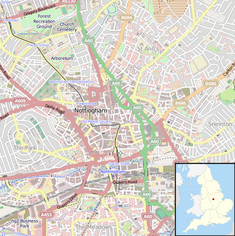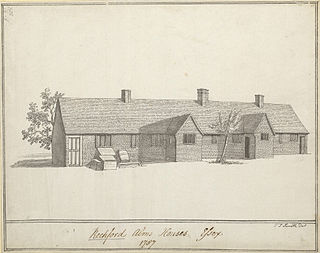
An almshouse is charitable housing provided to people in a particular community, especially during the Middle Ages. They were often targeted at the poor of a locality, at those from certain forms of previous employment, or their widows, and at elderly people who could no longer pay rent, and are generally maintained by a charity or the trustees of a bequest. Almshouses were originally formed as extensions of the church system and were later adapted by local officials and authorities.

Froxfield is a village and civil parish in the English county of Wiltshire. The parish is on the Wiltshire-West Berkshire border, and the village lies on the A4 national route about 2.5 miles (4 km) west of Hungerford and 7 miles (11 km) east of Marlborough.

Edward Colston was an English merchant, slave trader, philanthropist, and Tory Member of Parliament.
Bunny is a village and civil parish located in the Rushcliffe borough of Nottinghamshire, England. The parish has a population of around 600, measured at 689 in the 2011 Census. It is on the A60, 7 miles (11 km) south of Nottingham, south of Bradmore and north of Costock.

Ewelme is a village and civil parish in the Chiltern Hills in South Oxfordshire, 2.5 miles (4 km) north-east of the market town of Wallingford. The 2011 census recorded the parish's population as 1,048. To the east of the village is Cow Common and to the west, Benson Airfield, the north-eastern corner of which is within the parish boundary. The solid geology is chalk overlying gault clay; the drift geology includes some gravel.

King's Cliffe is a village and civil parish on Willow Brook, a tributary of the River Nene, about 9 miles (14 km) northeast of Corby in North Northamptonshire. The parish adjoins the county boundary with the City of Peterborough and the village is about 12 miles (19 km) west of the city centre. The village is not far from the boundary with Lincolnshire and about 6 miles (10 km) south of Stamford.

The Blockley Almshouse, later known as Philadelphia General Hospital, was a charity hospital and poorhouse located in West Philadelphia. It originally opened in 1732/33 in a different part of the city as the Philadelphia Almshouse. Philadelphia General Hospital closed in 1977.

The College of God's Gift, often referred to as the Old (Dulwich) College, was a historic charity founded in 1619 by the Elizabethan actor and businessman Edward Alleyn who endowed it with the ancient Manor of Dulwich in south London. In 1857 it was renamed as Alleyn's College of God's Gift. The charity was reorganised in 1882 and again in 1995, when its varied component activities were split up into separate registered charities. The former constituent elements of College of God's Gift, which have been independent charities since 1995, are:

The Hospital of St Cross and Almshouse of Noble Poverty is a medieval almshouse in Winchester, Hampshire, England. It has been described as "England's oldest and most perfect almshouse". Most of the buildings and grounds are open to the public at certain times. It is a Grade I listed building.
Abel Collin (1653–1705) was a benefactor in Nottingham. He established Abel Collin's Charity.

Gray's Almshouses is a terrace of almshouses in Taunton, Somerset, England, founded in 1635 by the wealthy cloth-merchant Robert Gray, whose monument survives in the Church of St Mary Magdalene. The building is one of the oldest surviving in Taunton and is one of the earliest brick buildings in the county. The Almshouses were designed to provide accommodation for six men and ten women and for a reader who was to act as chaplain and schoolmaster. It is a Grade I listed building as designated by English Heritage. Following renovation in the late twentieth century it now comprises sheltered accommodation of nine flats for the elderly.
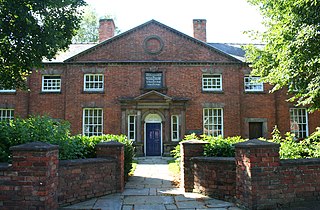
Crewe Almshouses or Crewe's Almshouses is a terrace of seven former almshouses at the end of Beam Street in Nantwich, Cheshire, England. The present building was erected in 1767 by John Crewe, later first Baron Crewe, and is listed at grade II. It has a central projecting section topped by a pediment, with a stone doorway flanked with Tuscan columns. The present almshouses stand on the site of a 16th-century building, originally the mansion of the Mainwaring family and later the town's House of Correction and workhouse.

The Tollemache Almshouses, also known as the Wilbraham Almshouses or Wilbraham's Almshouses, are six former almshouses in Nantwich, Cheshire, England. They are in two blocks of three cottages each, located on the north side of Welsh Row at numbers 118–128. The present buildings, which are listed at grade II, were erected in 1870 by John Tollemache to replace adjacent almshouses founded by Sir Roger Wilbraham in 1613. The almshouses were modernised in 1980 and remain in residential use. The Hospital of St Lawrence, a medieval house for lepers, was possibly on or near the site of the present almshouses.
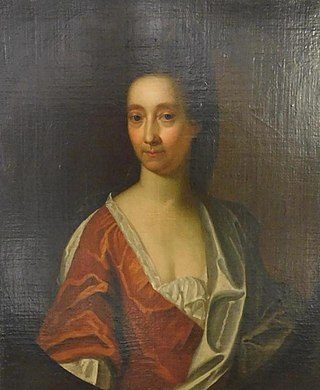
Sarah Hewley or Lady Sarah Hewley born Sarah Wolrych was a British benefactor. She created what is now the Lady Hewley Trust and she is remembered in York where she created almshouses and a chapel.

The Frances Jane Longden Almshouses were erected in 1852 in Bramcote, Nottinghamshire, for 4 poor women.

Bishop Dunbar's Hospital was founded in 1531 by Bishop Gavin Dunbar, the Elder. The hospital was endowed by a mortification just before his death. Dunbar petitioned the King, James V of Scotland, and the charter, signed on 24 February 1531 records the King’s approval that ‘[Dunbar shall] ... found an hospital near the cathedral church, but outside the cemetery...’ It was also known as St Mary's Hospital. In the mortification, Dunbar's charitable purpose is recorded. Bedesmen were supported by a charitable foundation that emerged from the original church control until the twenty-first century. Bedesmen drew their name from the word "bede" - a prayer. The residents of Dunbar's Hospital said prayers in a cycle of Divine Office. The Bede House, Old Aberdeen was used by the Bedesmen from the hospital from 1789 to the end of the nineteenth century. The only remains of the 1531 building can be seen in a perimeter wall for Seaton Park in Old Aberdeen. The last Bedesman died in 1988. The Managers of the Hospital constituted a Charity, Bishop Dunbar Hospital Trust. The Charity ceased active operation in 2012.
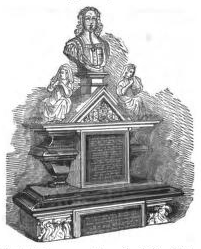
James Smith of Hammersmith, Middlesex, was an Alderman of the City of London a member of the Worshipful Company of Salters and a Governor of Christ's Hospital in London. His monument survives in St Paul's Church, Hammersmith. He was the grandfather of Sir John Smith, 1st Baronet, of Isleworth.
Hollis Hospital is an almshouse dating from 1703 in Sheffield, England.

